A Four Dimensional Variational Data Assimilation Framework for Wind Energy Potential Estimation
Abstract
1. Introduction
2. Preliminaries
2.1. Data Assimilation
2.2. Wind Energy Potential
3. Proposed Framework
3.1. Building an Ensemble of Snapshots
3.2. Adjoint-Free 4D-Var Optimization
3.3. Post-Processing of Data, Potential Energy Estimation
- whenever is necessary, the wind components of ensemble members are mapped to wind-speeds,
- this subset of information is exploited to estimate the wind energy potential of each analysis ensemble member:where is a function that maps model states to potential energy states (this is, for each ensemble member, its wind-speed components are mapped to wind energy potentials), where h is the number of wind-speed components (with ), and is the k-th transformed member. The mapping process depends on the wind turbine employed, for instance, one can consider the wind turbines discussed in Section 2.2.
3.4. Further Comments: Matrix-Free Formulation of the 4D-Var-MC
| Algorithm 1 Rank-one update of factors and via Doolittle’s method. | |
| 1: function Update_Rank_One(, , ) | ▹COST |
| 2: Solve . | ▹ |
| 3: Compute via Equation (20a). | ▹ |
| 4: for do | ▹ |
| 5: Let . | ▹ |
| 6: for do | ▹ |
| 7: Compute according to (20b). | ▹ |
| 8: end for | |
| 9: Compute via Equation (20c). | ▹ |
| 10: end for | |
| 11: Let . | ▹ |
| 12: return | |
| 13: end function | |
| Algorithm 2 Computing the posterior factors and of . | |
| 1: function Compute_Posterior_Cholesky_Factors(, , , ) | ▹COST |
| 2: Let . | ▹ |
| 3: Let | |
| 4: for do | ▹O times line 4, |
| 5: Let | ▹ |
| 6: end for | |
| 7: return as , as . | |
| 8: end function | |
4. Numerical Results
- Starting with a system in equilibrium, the model is integrated over a long time period to obtain an initial condition whose dynamics are consistent with those of the SPEEDY model.
- The initial condition is perturbed N times and propagated over a long-time period from which the initial background ensemble is obtained.
- We employ the trajectory of the initial condition as the reference one. This reference trajectory serves to build synthetic observations. Besides, we will consider that the actual potential capacities of WTGs are based on this solution.
- We let the standard deviations of errors in the observations as follows:
- -
- Temperature 1 K.
- -
- Zonal Wind Component 1 m/s.
- -
- Meridional Wind Component 1 m/s.
- -
- Specific Humidity g/kg.
- -
- Pressure 100 hPa.
- of model components are observed during assimilation steps. This linear observation operator is shown in Figure 2.
- Observations are available every six hours (6 h).
- The experiments are performed under perfect model assumptions.
- The number of assimilation steps reads . Thus, the simulation times is 7.5 days.
- We use the wind turbines discussed in Section 2.2 for computing wind potential energies.
- To estimate wind speeds, the wind fields (zonal and meridional components) are taken from the numerical grid at the pressure level 100 mb.
- Our results are compared with those obtained by the 4D-EnKF formulation.
- We employ the error norm as a measure of accuracy for the estimation of wind energy potential:where is the reference wind energy potential, and is the estimated one by a filter implementation. Likewise, k stands for observation time and v for wind speed.
- The Root-Mean-Square-Error (RMSE) provides an estimate of the performance of a filter for a given assimilation window:
- We estimate the potential energy capacities of Wind Turbines Generators (WTGs) discussed in Section 2.2.
- Our numerical results are compared with those of the 4D-EnKF formulation discussed in Section 2.
4.1. Results with of Observations from the Model State
4.2. Single Observations across Observation Times
5. Conclusions
Author Contributions
Funding
Acknowledgments
Conflicts of Interest
References
- Nino-Ruiz, E.D. Implicit surrogate models for trust region based methods. J. Comput. Sci. 2018, 26, 164–274. [Google Scholar] [CrossRef]
- Nino-Ruiz, E.D.; Cheng, H.; Beltran, R. A Robust Non-Gaussian Data Assimilation Method for Highly Non-Linear Models. Atmosphere 2018, 9, 126. [Google Scholar] [CrossRef]
- Lorenc, A.C. The potential of the ensemble Kalman filter for NWP—A comparison with 4D-Var. Q. J. R. Meteorol. Soc. A J. Atmos. Sci. Appl. Meteorol. Phys. Oceanogr. 2003, 129, 3183–3203. [Google Scholar] [CrossRef]
- Lorenc, A.C. Modelling of error covariances by 4D-Var data assimilation. Q. J. R. Meteorol. Soc. A J. Atmos. Sci. Appl. Meteorol. Phys. Oceanogr. 2003, 129, 3167–3182. [Google Scholar] [CrossRef]
- Fay, M.; Andres, L.A.; Fox, C.; Narloch, U.; Slawson, M. Rethinking Infrastructure in Latin America and the Caribbean: Spending Better to Achieve More; World Bank Publications: Washington, DC, USA, 2017. [Google Scholar]
- Del Río, P.; Burguillo, M. Assessing the impact of renewable energy deployment on local sustainability: Towards a theoretical framework. Renew. Sustain. Energy Rev. 2008, 12, 1325–1344. [Google Scholar] [CrossRef]
- Vergara, W.; Isbell, P.; Rios, A.R.; Gómez, J.R.; Alves, L. Societal Benefits from Renewable Energy in Latin America and the Caribbean; Technical report; Inter-American Development Bank: Washington, DC, USA, 2014. [Google Scholar]
- Munoz, F.D.; Wogrin, S.; Oren, S.S.; Hobbs, B.F. Economic Inefficiencies of Cost-based Electricity Market Designs. In Proceedings of the Heading Towards Sustainable Energy Systems: Evolution or Revolution? 15th IAEE European Conference International Association for Energy Economics, Vienna, Austria, 3–6 September 2017. [Google Scholar]
- Griffith-Jones, S.; Spratt, S.; Andrade, R.; Griffith-Jones, E. Investment in Renewable Energy, Fossil Fuel Prices and Policy Implications for Latin America and the Caribbean. 2017. Available online: https://repositorio.cepal.org/handle/11362/41679 (accessed on 3 January 2020).
- Gustafsson, N.; Bojarova, J. Four-dimensional ensemble variational (4D-En-Var) data assimilation for the high resolution limited area model (HIRLAM). Nonlinear Process. Geophys. 2014, 21, 745–762. [Google Scholar] [CrossRef]
- Stengel, M.; Undén, P.; Lindskog, M.; Dahlgren, P.; Gustafsson, N.; Bennartz, R. Assimilation of SEVIRI infrared radiances with HIRLAM 4D-Var. Q. J. R. Meteorol. Soc. A J. Atmos. Sci. Appl. Meteorol. Phys. Oceanogr. 2009, 135, 2100–2109. [Google Scholar] [CrossRef]
- Gustafsson, N. Discussion on ‘4D-Var or EnKF?’. Tellus A Dyn. Meteorol. Oceanogr. 2007, 59, 774–777. [Google Scholar] [CrossRef]
- Nino-Ruiz, E.D.; Sandu, A. Ensemble Kalman filter implementations based on shrinkage covariance matrix estimation. Ocean Dyn. 2015, 65, 1423–1439. [Google Scholar] [CrossRef]
- Houtekamer, P.L.; Mitchell, H.L. Data assimilation using an ensemble Kalman filter technique. Mon. Weather Rev. 1998, 126, 796–811. [Google Scholar] [CrossRef]
- Stroud, J.R.; Katzfuss, M.; Wikle, C.K. A Bayesian adaptive ensemble Kalman filter for sequential state and parameter estimation. Mon. Weather Rev. 2018, 146, 373–386. [Google Scholar] [CrossRef]
- Goodliff, M.; Amezcua, J.; Van Leeuwen, P.J. Comparing hybrid data assimilation methods on the Lorenz 1963 model with increasing non-linearity. Tellus A Dyn. Meteorol. Oceanogr. 2015, 67, 26928. [Google Scholar] [CrossRef]
- Nino-Ruiz, E.D.; Sandu, A. A derivative-free trust region framework for variational data assimilation. J. Comput. Appl. Math. 2016, 293, 164–179. [Google Scholar] [CrossRef]
- Greybush, S.J.; Kalnay, E.; Miyoshi, T.; Ide, K.; Hunt, B.R. Balance and ensemble Kalman filter localization techniques. Mon. Weather Rev. 2011, 139, 511–522. [Google Scholar] [CrossRef]
- Chen, Y.; Oliver, D.S. Cross-covariances and localization for EnKF in multiphase flow data assimilation. Comput. Geosci. 2010, 14, 579–601. [Google Scholar] [CrossRef]
- Lei, L.; Whitaker, J.S.; Bishop, C. Improving assimilation of radiance observations by implementing model space localization in an ensemble Kalman filter. J. Adv. Model. Earth Syst. 2018, 10, 3221–3232. [Google Scholar] [CrossRef]
- Anderson, J.L. An ensemble adjustment Kalman filter for data assimilation. Mon. Weather Rev. 2001, 129, 2884–2903. [Google Scholar] [CrossRef]
- Han, Y.; Zhang, J.; Sun, D. Error control and adjustment method for underwater wireless sensor network localization. Appl. Acoust. 2018, 130, 293–299. [Google Scholar] [CrossRef]
- Anderson, J.L. A Nonlinear Rank Regression Method for Ensemble Kalman Filter Data Assimilation. Mon. Weather Rev. 2019, 147, 2847–2860. [Google Scholar] [CrossRef]
- Levina, E.; Rothman, A.; Zhu, J. Sparse estimation of large covariance matrices via a nested lasso penalty. Ann. Appl. Stat. 2008, 2, 245–263. [Google Scholar] [CrossRef]
- Nino-Ruiz, E.D.; Sandu, A.; Deng, X. A parallel implementation of the ensemble Kalman filter based on modified Cholesky decomposition. J. Comput. Sci. 2017. [Google Scholar] [CrossRef]
- Nino-Ruiz, E.D.; Sandu, A.; Deng, X. An Ensemble Kalman Filter Implementation Based on Modified Cholesky Decomposition for Inverse Covariance Matrix Estimation. SIAM J. Sci. Comput. 2018, 40, A867–A886. [Google Scholar] [CrossRef]
- Bickel, P.J.; Levina, E. Regularized estimation of large covariance matrices. Ann. Stat. 2008, 36, 199–227. [Google Scholar] [CrossRef]
- Kopiske, J.; Spieker, S.; Tsatsaronis, G. Value of power plant flexibility in power systems with high shares of variable renewables: A scenario outlook for Germany 2035. Energy 2017, 137, 823–833. [Google Scholar] [CrossRef]
- Liu, Z. China’s strategy for the development of renewable energies. Energy Sources Part B Econ. Plan. Policy 2017, 12, 971–975. [Google Scholar] [CrossRef]
- Verzijlbergh, R.; De Vries, L.; Dijkema, G.; Herder, P. Institutional challenges caused by the integration of renewable energy sources in the European electricity sector. Renew. Sustain. Energy Rev. 2017, 75, 660–667. [Google Scholar] [CrossRef]
- Xie, K.; Billinton, R. Determination of the optimum capacity and type of wind turbine generators in a power system considering reliability and cost. IEEE Trans. Energy Convers. 2010, 26, 227–234. [Google Scholar] [CrossRef]
- Wiser, R. Annual Report on US Wind Power Installation, Cost, and Performance Trends: 2007; Technical report; EERE Publication and Product Library: Washington, DC, USA, 2008. [Google Scholar]
- Masters, G.M. Renewable and Efficient Electric Power Systems; John Wiley & Sons: New York, NY, USA, 2013. [Google Scholar]
- Amezcua, J.; Kalnay, E.; Williams, P.D. The effects of the RAW filter on the climatology and forecast skill of the SPEEDY model. Mon. Weather Rev. 2011, 139, 608–619. [Google Scholar] [CrossRef]
- Michalakes, J.; Dudhia, J.; Gill, D.; Henderson, T.; Klemp, J.; Skamarock, W.; Wang, W. The weather research and forecast model: Software architecture and performance. In Use of High Performance Computing in Meteorology; World Scientific: Singapore, 2005; pp. 156–168. [Google Scholar]
- Michalakes, J.; Chen, S.; Dudhia, J.; Hart, L.; Klemp, J.; Middlecoff, J.; Skamarock, W. Development of a next-generation regional weather research and forecast model. In Developments in Teracomputing; World Scientific: Singapore, 2001; pp. 269–276. [Google Scholar]
- Nino-Ruiz, E.D.; Sandu, A.; Anderson, J. An efficient implementation of the ensemble Kalman filter based on an iterative Sherman–Morrison formula. Stat. Comput. 2015, 25, 561–577. [Google Scholar] [CrossRef]
- Nino-Ruiz, E. A matrix-free posterior ensemble kalman filter implementation based on a modified cholesky decomposition. Atmosphere 2017, 8, 125. [Google Scholar] [CrossRef]
- Bracco, A.; Kucharski, F.; Kallummal, R.; Molteni, F. Internal variability, external forcing and climate trends in multi-decadal AGCM ensembles. Clim. Dyn. 2004, 23, 659–678. [Google Scholar] [CrossRef]
- Miyoshi, T. The Gaussian approach to adaptive covariance inflation and its implementation with the local ensemble transform Kalman filter. Mon. Weather Rev. 2011, 139, 1519–1535. [Google Scholar] [CrossRef]
- Molteni, F. Atmospheric simulations using a GCM with simplified physical parametrizations. I: Model climatology and variability in multi-decadal experiments. Clim. Dyn. 2003, 20, 175–191. [Google Scholar] [CrossRef]
- Kucharski, F.; Molteni, F.; Bracco, A. Decadal interactions between the western tropical Pacific and the North Atlantic Oscillation. Clim. Dyn. 2006, 26, 79–91. [Google Scholar] [CrossRef]
- Miyoshi, T.; Kondo, K.; Imamura, T. The 10,240-member ensemble Kalman filtering with an intermediate AGCM. Geophys. Res. Lett. 2014, 41, 5264–5271. [Google Scholar] [CrossRef]
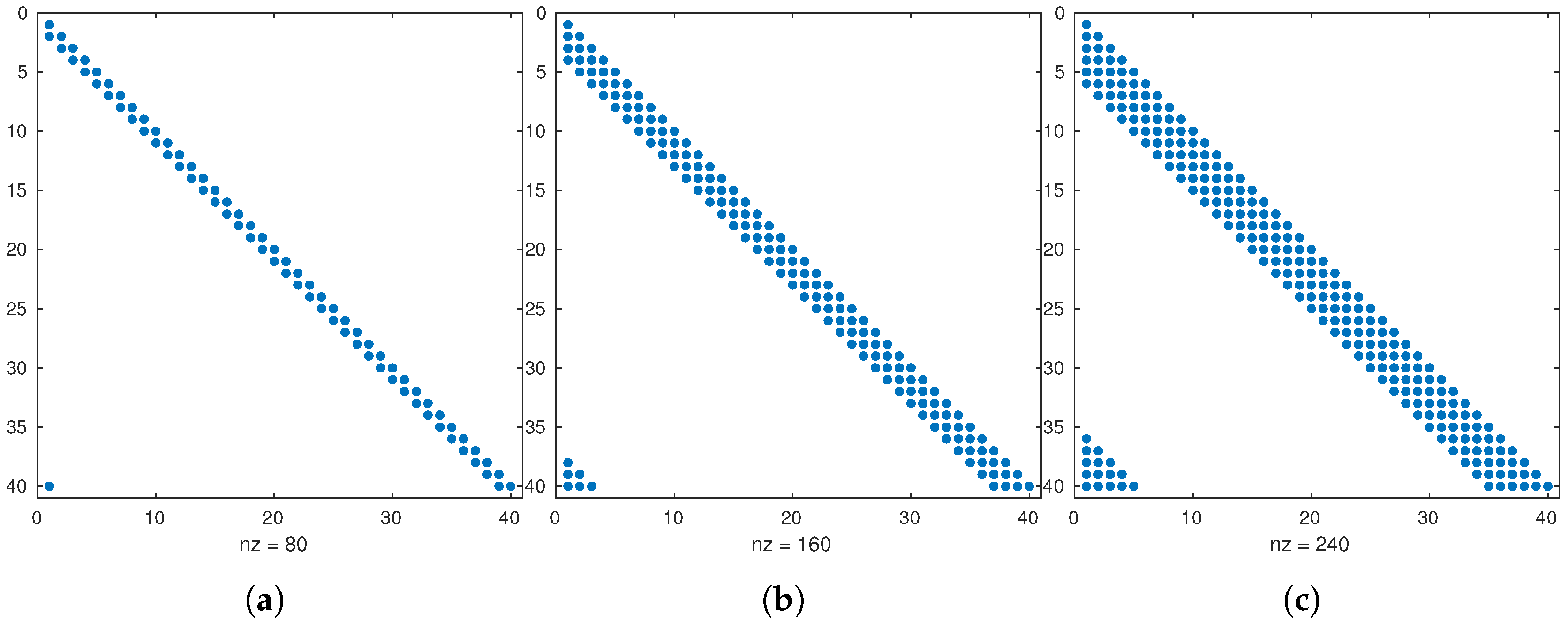
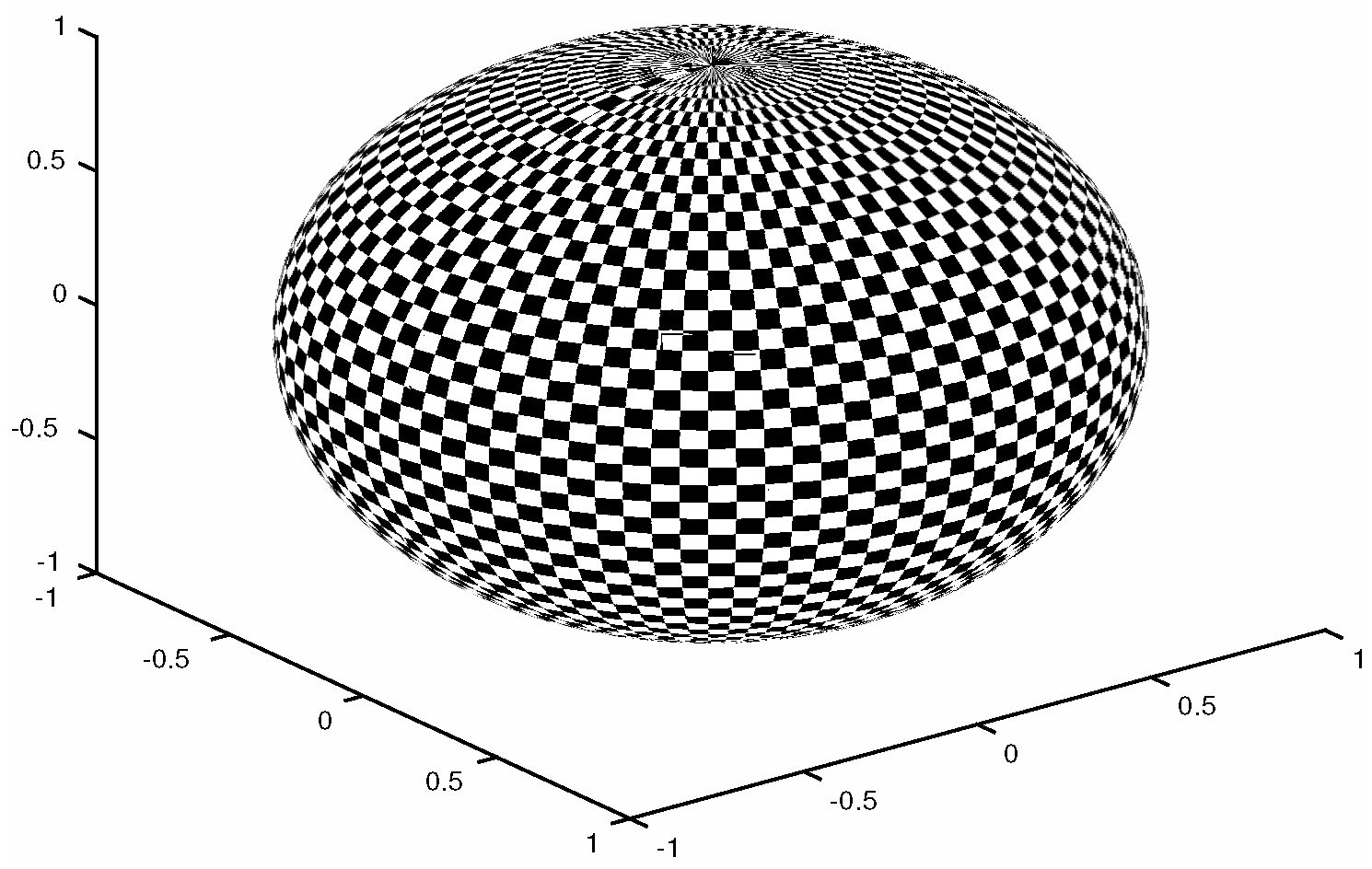
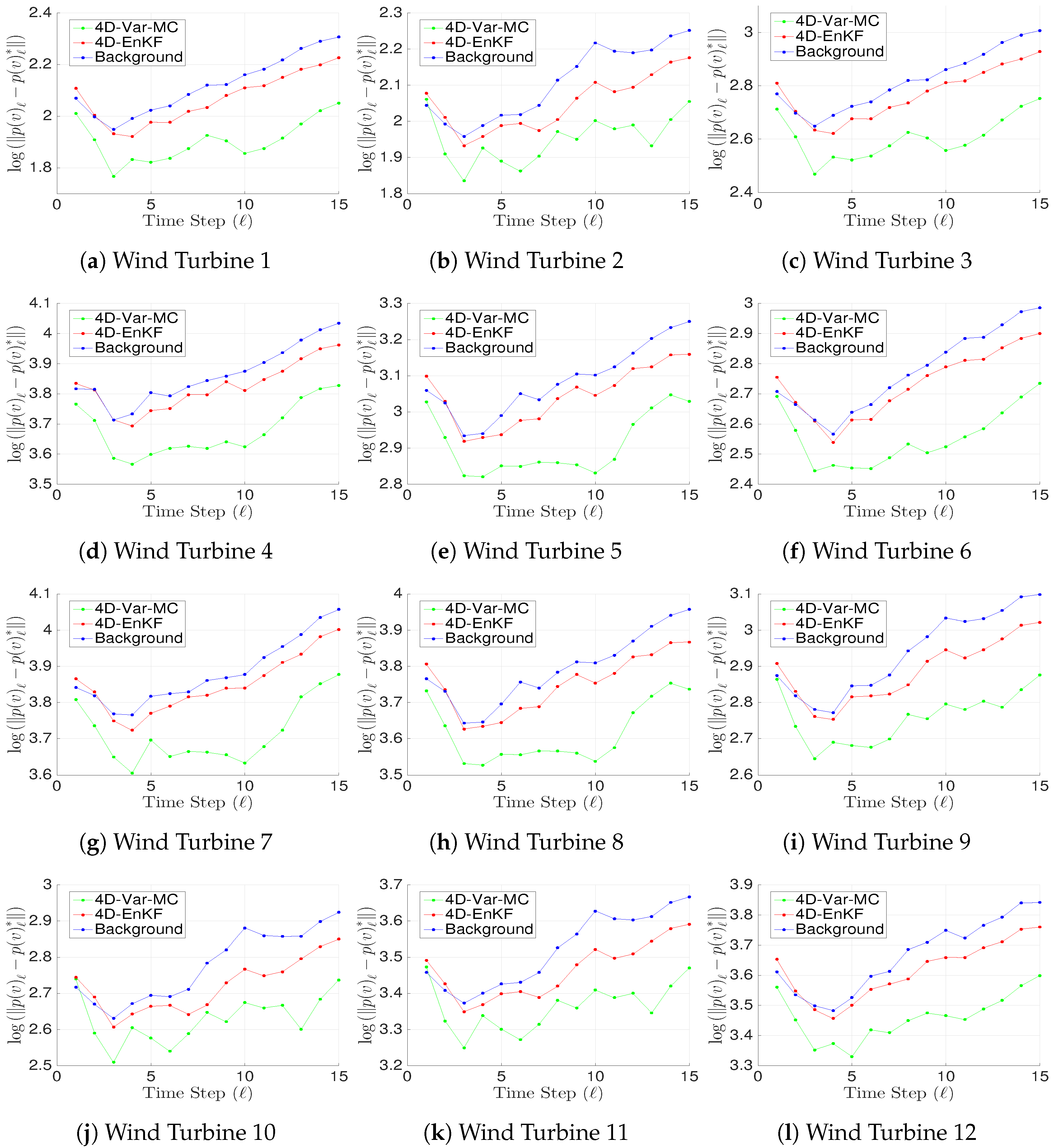
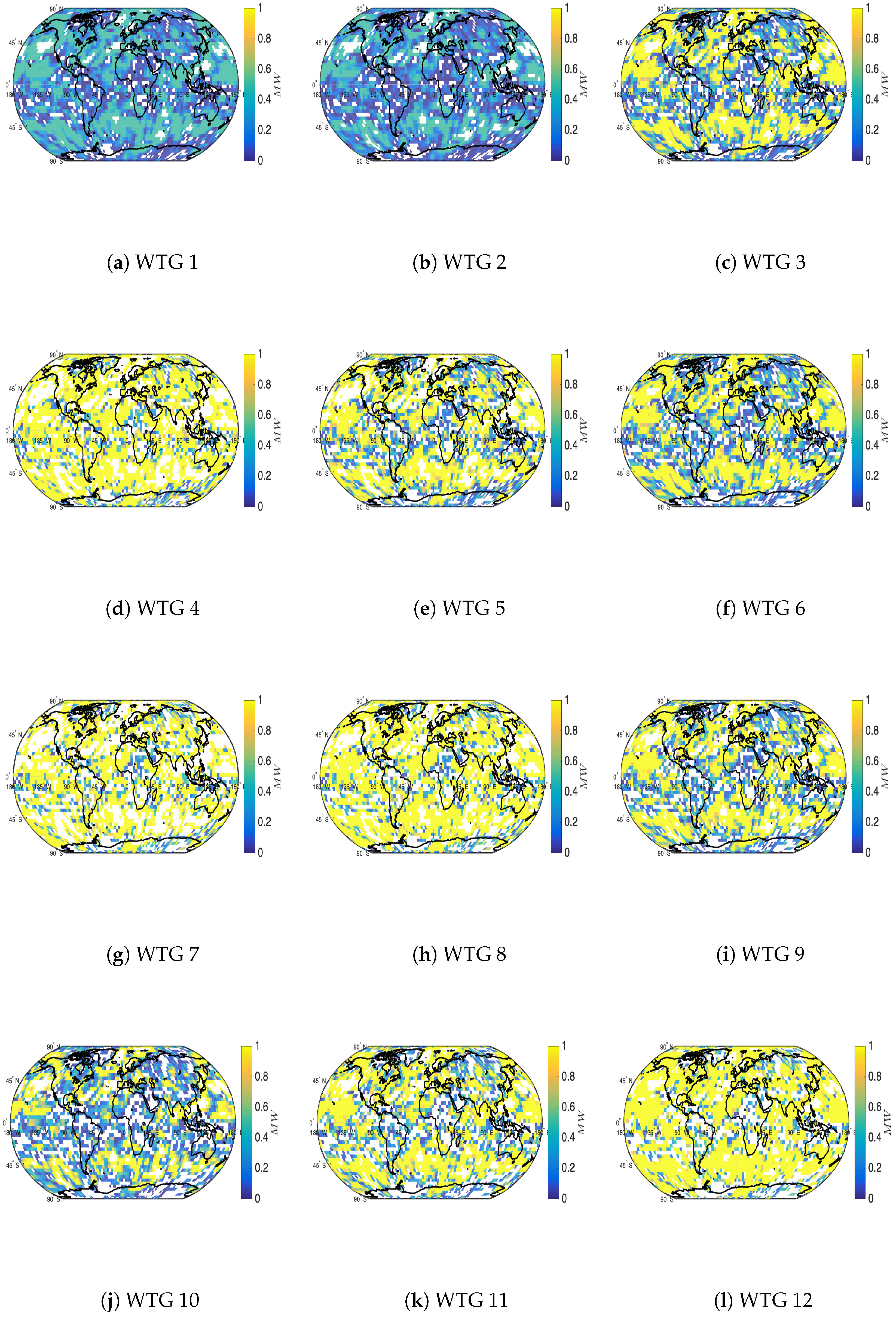
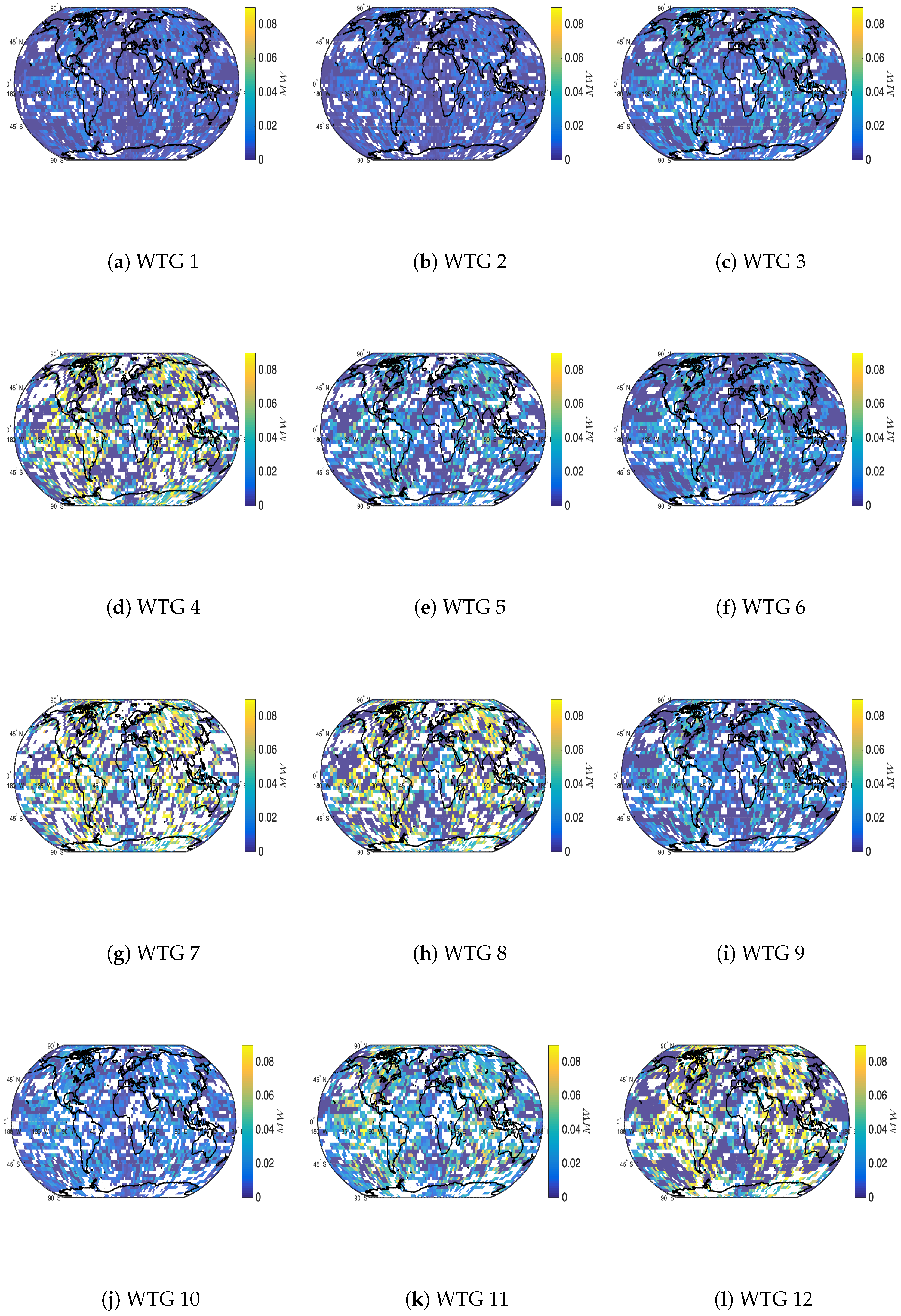
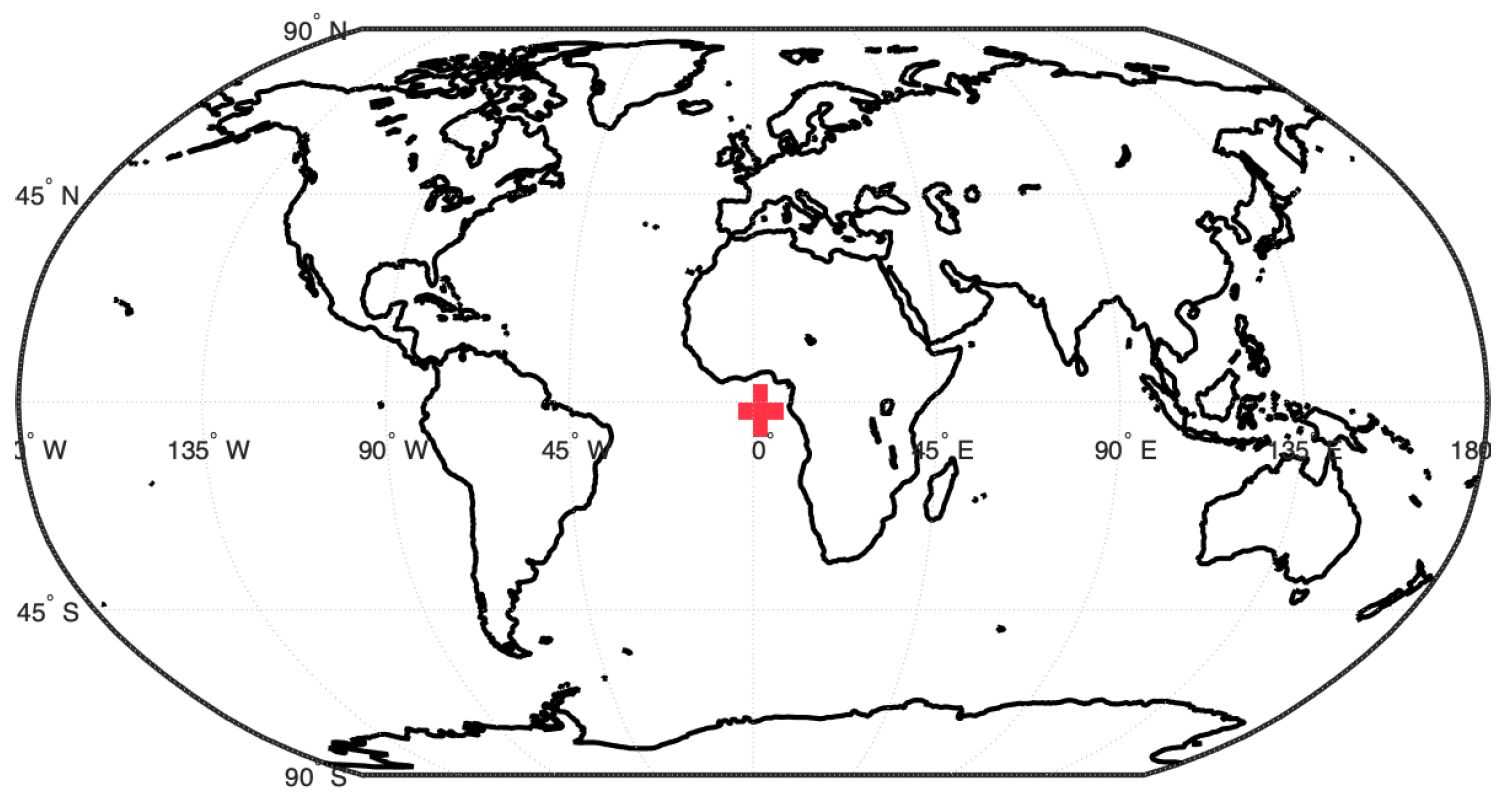
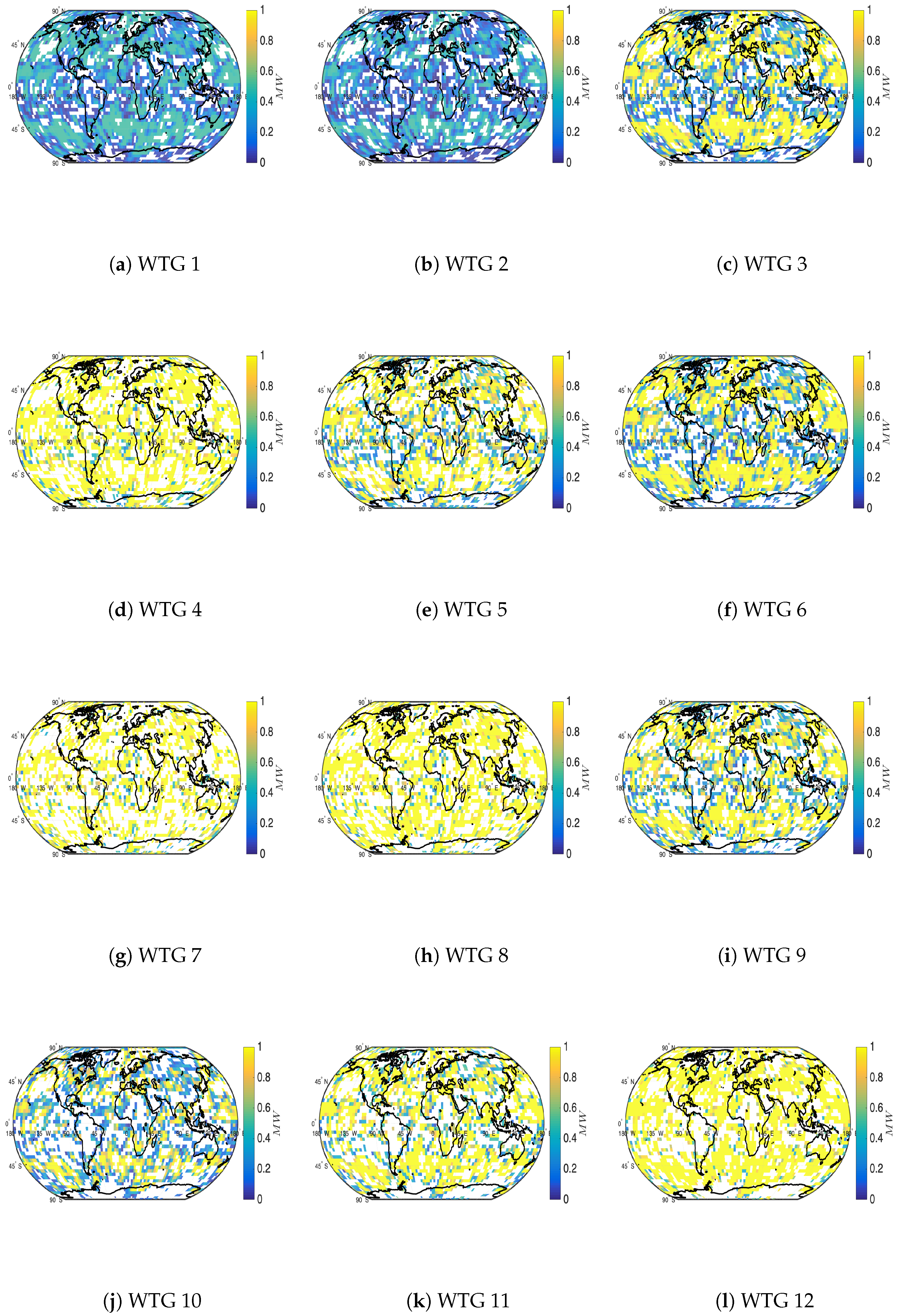
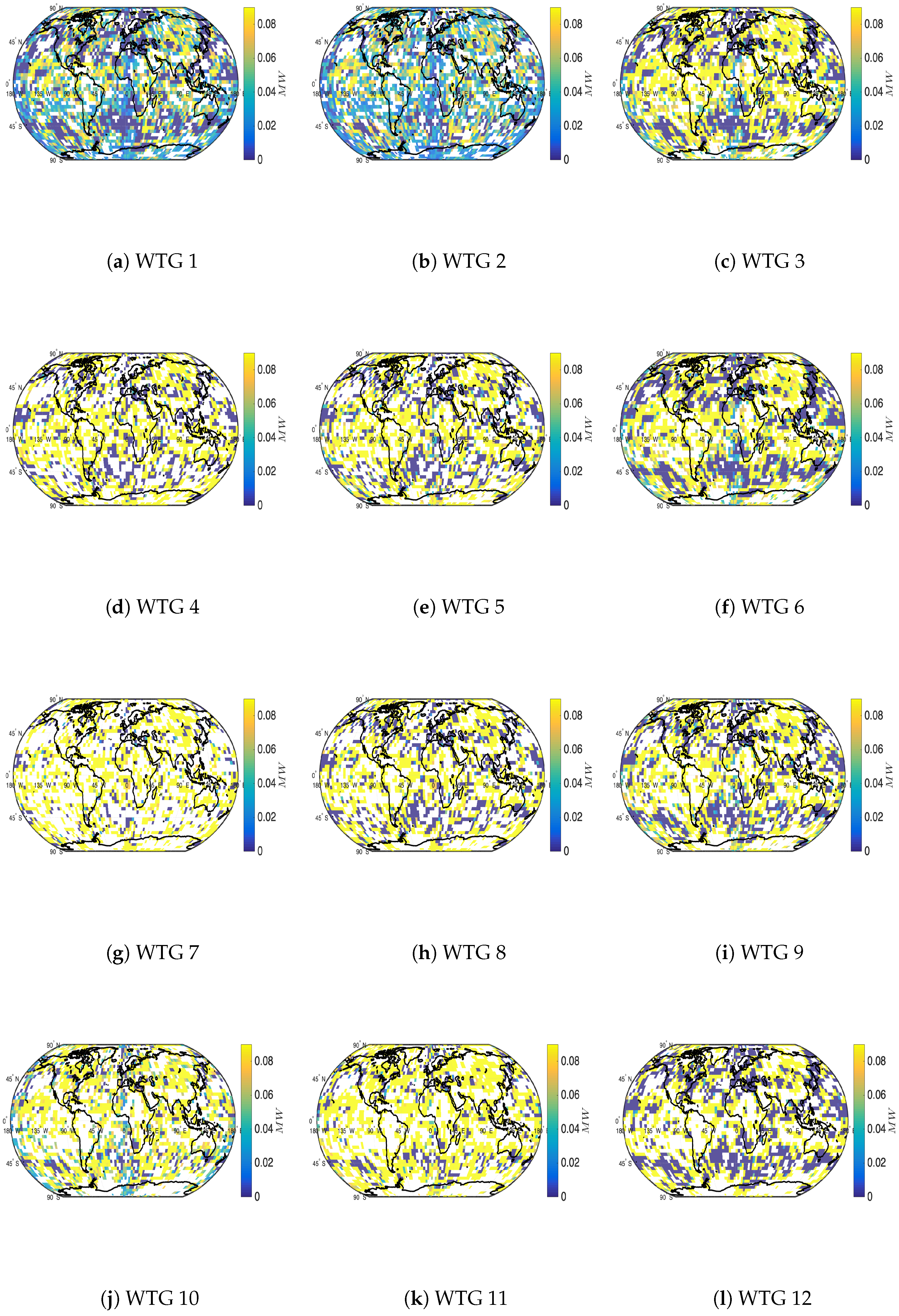
| Type | Rated Capacity (MW) | (km/h) | (km/h) | (km/h) | Capital Cost | |
|---|---|---|---|---|---|---|
| WTG 1 | 0.5 | 10 | 40 | 80 | 1350 | 36 |
| WTG 2 | 0.5 | 10 | 45 | 70 | 1350 | 36 |
| WTG 3 | 1 | 12 | 40 | 80 | 1250 | 35 |
| WTG 4 | 2 | 12 | 30 | 55 | 1120 | 30 |
| WTG 5 | 1 | 13 | 33 | 60 | 1220 | 33 |
| WTG 6 | 1 | 14 | 40 | 90 | 1250 | 32 |
| WTG 7 | 2 | 15 | 33 | 50 | 1100 | 35 |
| WTG 8 | 2 | 15 | 33 | 60 | 1100 | 30.5 |
| WTG 9 | 1 | 15 | 37 | 70 | 1200 | 32 |
| WTG 10 | 1 | 18 | 48 | 70 | 1250 | 32 |
| WTG 11 | 2 | 18 | 45 | 70 | 1100 | 30 |
| WTG 12 | 2 | 18 | 35 | 75 | 1100 | 30 |
| Name | Notation | Units | Number of Layers |
|---|---|---|---|
| Temperature | T | K | 7 |
| Zonal Wind Component | u | m/s | 7 |
| Meridional Wind Component | v | m/s | 7 |
| Specific Humidity | Q | g/kg | 7 |
| Pressure | T | K | 1 |
| N | ||||
|---|---|---|---|---|
| 20 | 40 | |||
| Wind Turbine Generator (WTG) | 4D-EnKF | 4D-Var-MC | 4D-EnKF | 4D-Var-MC |
| WTG 1 | 0.11713 | 0.09927 | 0.11211 | 0.10098 |
| WTG 2 | 0.11481 | 0.10391 | 0.11143 | 0.10596 |
| WTG 3 | 0.23608 | 0.20008 | 0.22597 | 0.20354 |
| WTG 4 | 0.67597 | 0.58524 | 0.65088 | 0.59049 |
| WTG 5 | 0.31010 | 0.27093 | 0.29692 | 0.27475 |
| WTG 6 | 0.22808 | 0.19058 | 0.21876 | 0.19488 |
| WTG 7 | 0.69412 | 0.60609 | 0.67170 | 0.61034 |
| WTG 8 | 0.62901 | 0.54901 | 0.60232 | 0.55692 |
| WTG 9 | 0.26503 | 0.23305 | 0.25554 | 0.23756 |
| WTG 10 | 0.22425 | 0.20466 | 0.21797 | 0.20872 |
| WTG 11 | 0.47221 | 0.42631 | 0.45824 | 0.43497 |
| WTG 12 | 0.55006 | 0.47031 | 0.52981 | 0.47967 |
| Data Assimilation Method | ||
|---|---|---|
| Wind Turbine Generator (WTG) | 4D EnKf | 4D EnKf-Cho |
| WTG 1 | 10.4452 | 8.5893 |
| WTG 2 | 10.3149 | 8.4186 |
| WTG 3 | 21.0570 | 17.3117 |
| WTG 4 | 58.1186 | 49.0419 |
| WTG 5 | 27.2986 | 22.9304 |
| WTG 6 | 20.4388 | 16.4551 |
| WTG 7 | 59.4296 | 50.3057 |
| WTG 8 | 55.3220 | 46.4524 |
| WTG 9 | 23.5265 | 19.2920 |
| WTG 10 | 20.2342 | 16.5172 |
| WTG 11 | 42.4308 | 34.6328 |
| WTG 12 | 48.3756 | 40.4795 |
© 2020 by the authors. Licensee MDPI, Basel, Switzerland. This article is an open access article distributed under the terms and conditions of the Creative Commons Attribution (CC BY) license (http://creativecommons.org/licenses/by/4.0/).
Share and Cite
Nino-Ruiz, E.D.; Calabria-Sarmiento, J.C.; Guzman-Reyes, L.G.; Henao, A. A Four Dimensional Variational Data Assimilation Framework for Wind Energy Potential Estimation. Atmosphere 2020, 11, 167. https://doi.org/10.3390/atmos11020167
Nino-Ruiz ED, Calabria-Sarmiento JC, Guzman-Reyes LG, Henao A. A Four Dimensional Variational Data Assimilation Framework for Wind Energy Potential Estimation. Atmosphere. 2020; 11(2):167. https://doi.org/10.3390/atmos11020167
Chicago/Turabian StyleNino-Ruiz, Elias D., Juan C. Calabria-Sarmiento, Luis G. Guzman-Reyes, and Alvin Henao. 2020. "A Four Dimensional Variational Data Assimilation Framework for Wind Energy Potential Estimation" Atmosphere 11, no. 2: 167. https://doi.org/10.3390/atmos11020167
APA StyleNino-Ruiz, E. D., Calabria-Sarmiento, J. C., Guzman-Reyes, L. G., & Henao, A. (2020). A Four Dimensional Variational Data Assimilation Framework for Wind Energy Potential Estimation. Atmosphere, 11(2), 167. https://doi.org/10.3390/atmos11020167





